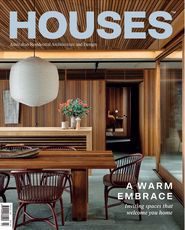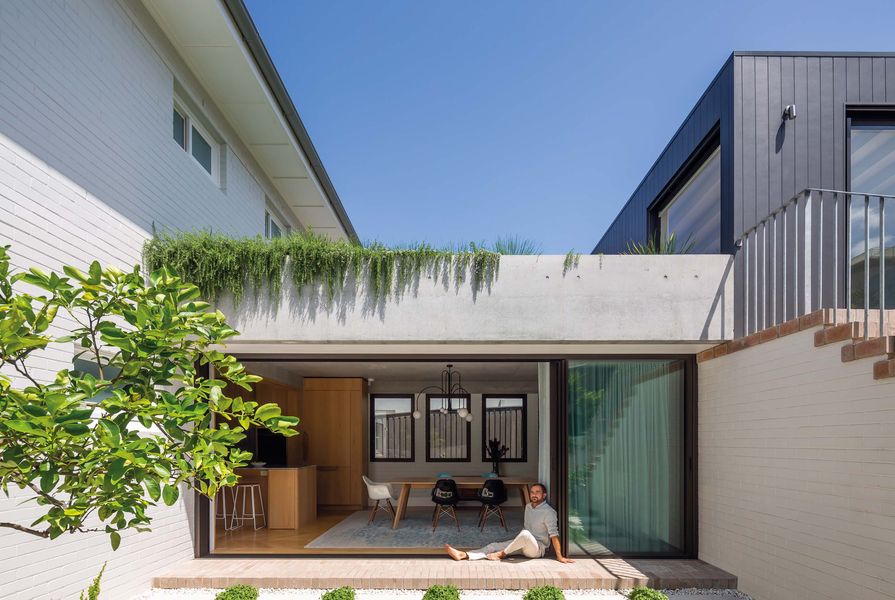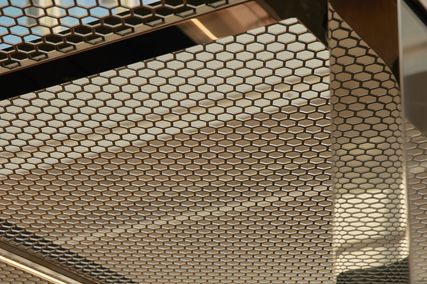The adaptation of old housing stock is a common challenge presented to residential architects, who are tasked with rectifying the failings of outdated buildings and poorly planned additions. “People keep extending and extending until you get what I call a ‘fat house’ with no light and no ventilation,” says the director of Marston Architects, Vivianne Marston. In the case of O House, Vivianne and her team have adapted a squat brick box in the Sydney suburb of Manly – formerly housing two duplexes, and unsympathetically extended over the years – into a light and bright residential home that effortlessly flows up a sloped site from front to back.
The first step in the new design was to remove the existing extension and a retaining wall, and to demolish the garage, which was inefficiently located in the middle of the raised rear yard. Another complication was the level change from the street at the front of the house to the backyard and rear lane, four metres higher than the front. The solution was to create a new, raised addition at the back of the house on the southern side, leaving the northern side for gardens, including a courtyard at the lower level that connects to the dining room in the old house, and a pool and vegetable patch up the stairs at the back.
A common-sense new layout, which includes centrally located kitchen and dining zones, brings the family together. Artwork: Mark Cross.
Image: Simon Whitbread
The finished house is a study in flow – with the existing living space in the old part of the house seamlessly shifting into the new extension through the ground-floor kitchen/dining space, then leading to a lower room at the back for a cellar and storage, and upstairs to an extra rumpus room and garage behind. “It was a brave decision to demolish the old garage, but in the past, to access it you had to circulate through this very narrow corridor up the stairs, which was quite hopeless,” says Vivianne. The first floor of the extension can now be accessed via internal stairs or external brick stairs in the garden.
While the circulation is seamless, the extension deliberately contrasts with the original house architecturally. Where the old house has a pitched roof and smaller windows, the new extension has a flat roof and larger windows and sliding doors. The materials are also different. Where the original house has horizontal white brick with white timber-framed windows, the new extension features a dark vertical-joint timber cladding and dark bronze anodized aluminium windows. “The linking elements are the same, but these major elements are very different,” explains Vivianne. “Because the brickwork on the main house goes horizontally, it was very intentional to go vertically.”
The dining pavilion spills onto a north-facing deck. Artwork: Mark Cross.
Image: Simon Whitbread
In the old part of the house, original features such as decorative plasterwork were retained where possible, while other things had to go, such as the leaking terracotta tile roof, which is now metal. A sense of history has also been retained with the furniture, which includes several mid-century timber sideboards, two of which have been converted into vanities in the bathrooms. At the front of the house, new bay windows in the sun room and guest bedroom on the ground floor retain the character of the 1930s style of the home, but have been sized up. “Originally the technology didn’t exist to have such large panes of glass,” says Vivianne. “Our idea was to combine the contemporary ability to have uninterrupted views but pick up on some of the original detailing as well.”
The architects closely worked with the client and the builder, Synergy One Building, on the project, with the rooftop garden above the dining room being one of the most complicated aspects of the build. The garden had to be carefully designed and constructed so as to be watertight – luckily, the builders had experience working on this kind of structure before. Here, every detail has been taken into consideration – the roof with trailing planters slightly juts out over the dining room, softening the edge of the building and creating a sense that there is greenery cascading down from above.
A green roof disguises the sloped site and improves the house’s connection to outdoor spaces.
Image: Simon Whitbread
The house is connected to gardens as much as possible. Large windows at the front look out to the front yard, while the dining room opens up for an expansive connection to the courtyard. In the rear addition, the rumpus room spills onto the top yard with a vegetable patch and pool behind it.
With a neutral colour scheme and common-sense layout, what stands out in this project is its liveability, something that Vivianne has developed a knack for creating in her nearly 40 years of practice. “I would hope that our work is not creating masterpieces that people don’t feel comfortable living in,” she says. “I’m really delighted when I come here and [the client] has her art happening in one corner and music happening in another corner and gardening happening outside. To me that shows that the house is being used.”
Products and materials
- Roofing
- Custom Orb roofing and Kliplok decking by Lysaght in Colorbond ‘Monument’
- External walls
- James Hardie Axon cladding (smooth) in Resene ‘Nocturnal’; existing brickwork and shingles finished with Resene in ‘Foggy Grey’ (quarter strength)
- Internal walls
- Dulux paint in ‘Terrace White’
- Windows
- Timber windows by Artarmon Joinery in Dulux ‘Alabaster’; glazing by Narrowline Glass; aluminium windows by Award Architectural Aluminium in bronze anodized finish
- Doors
- Solid-core doors from Hardware and General; sliding door by Artarmon Joinery; pivot front door by Cedar West and handle by Custom Spaces; custom refrigerator door handle by Custom Spaces; all other knobs Reeded Mortice by Tradco
- Flooring
- Tongue-and-groove European Oak installed by D And D Flooring in matt Bona Traffic finish; Ming large mosaic hexagons from Evotiles; Luxe Tone carpet from Carpet Court in ‘Tanzanite’
- Lighting
- Tovo downlights; Light In The Box statement lights
- Kitchen
- Franke oven and tap; AEG induction hob; Asko gas burner; Qasair extractor fan; Oliveri sink; Fisher and Paykel dishwasher and refrigerator; Arc Hydrotap by Zip; Castillo Grigio marble benchtop by RMS Traders
- Bathroom
- City Plus tapware by Brodware; vanities from repurposed Noblett sideboards
- Heating and cooling
- Daikin HVAC
- External elements
- Bowral Simmental Silver terrace and stair pavers from Austral Bricks; marble for pool coping, pathways and courtyard from Ela Stone
- Other
- American oak interior stairs by Custom Spaces; internal and external steel balustrades by Vision Balustrades
Credits
- Project
- O House by Marston Architects
- Architect
- Marston Architects
Sydney, NSW, Australia
- Project Team
- Vivianne Marston, Pip Marston, Pouwel Wind, Matthew Argent
- Consultants
-
Builder
Synergy One Building
Engineer Benvenuti S. C.
Joinery, stairs and custom furniture Brett Columbus, Custom Spaces
Lighting Tovo Lighting
Pool and site planning Marston Architects
Pool construction Poolform Constructions
Quantity surveyor QS Plus
- Site Details
-
Location
Sydney,
NSW,
Australia
Site type Suburban
Site area 435 m2
Building area 240 m2
- Project Details
-
Status
Built
Completion date 2021
Design, documentation 12 months
Construction 15 months
Category Residential
Type Alts and adds
Source

Project
Published online: 1 Jul 2022
Words:
Penny Craswell
Images:
Marston Architects,
Simon Whitbread
Issue
Houses, June 2022
























